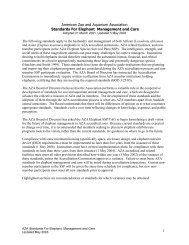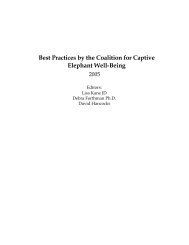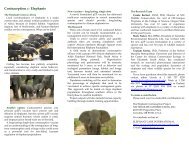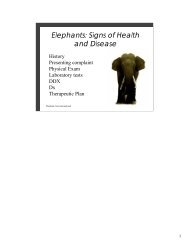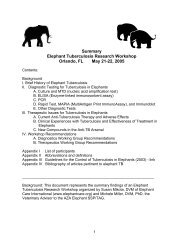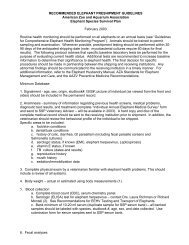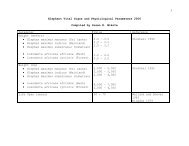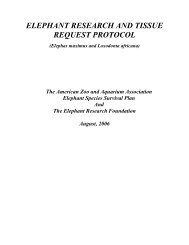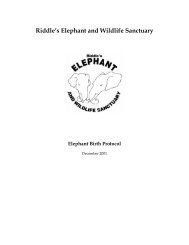Nepal Elephant TB Control and Mgt Action Plan.pdf - Elephant Care ...
Nepal Elephant TB Control and Mgt Action Plan.pdf - Elephant Care ...
Nepal Elephant TB Control and Mgt Action Plan.pdf - Elephant Care ...
- No tags were found...
You also want an ePaper? Increase the reach of your titles
YUMPU automatically turns print PDFs into web optimized ePapers that Google loves.
<strong>Nepal</strong> <strong>Elephant</strong> Tuberculosis ulosis<strong>Control</strong> <strong>and</strong>Management agemen<strong>Action</strong> <strong>Plan</strong> (2011-2015)2015)Treatment for <strong>TB</strong> amongst elephants began in2008. Exposure to known cases of <strong>TB</strong> <strong>and</strong> areacve <strong>Elephant</strong> <strong>TB</strong> Stat-Pak ® result were iniallyused as the basis for treatment. The currentdecision tree includes the DPP ® Vet<strong>TB</strong> test (see1.5. <strong>TB</strong> Treatment Protocol).Roune surveillance of elephants <strong>and</strong> theirh<strong>and</strong>lers together with early diagnosis <strong>and</strong>treatment are essenal to control <strong>TB</strong>. It is hopedthat these guidelines will serve as a science-basedmodel for other Asian elephant range countries.The <strong>Nepal</strong> <strong>Elephant</strong> Tuberculosis (<strong>TB</strong>) <strong>Control</strong><strong>and</strong> Management Acon <strong>Plan</strong> (NETCMAP) isbased on a goal of minimizing the risk of <strong>TB</strong>transmission from capve elephants to the wildby managing <strong>TB</strong> at the capve-wild interface Thisplan outlines methods to diagnose, treat, <strong>and</strong>manage <strong>TB</strong> in elephants in <strong>Nepal</strong>. The <strong>TB</strong> control<strong>and</strong> management program will be launched bythe Ministry of Forests <strong>and</strong> Soil Conservaon- Department of Naonal Parks <strong>and</strong> WildlifeConservaon (DNPWC) with technical supportfrom naonal <strong>and</strong> internaonal conservaonpartners including the Naonal Trust for NatureConservaon (NTNC) <strong>Nepal</strong>, the Buffer ZoneManagement Commi ees (BZMCs) <strong>Nepal</strong>,<strong>Elephant</strong> <strong>Care</strong> Internaonal (ECI) USA, WorldWildlife Fund (WWF) <strong>Nepal</strong>, <strong>and</strong> the HotelAssociaon of <strong>Nepal</strong> (HAN). The plan will beimplemented under the close supervision of aveterinarian with adequate knowledge on animal<strong>TB</strong>.1.2 <strong>TB</strong> Tesng Procedures <strong>and</strong>Management GroupsThe <strong>TB</strong> <strong>Plan</strong> Veterinary Officer <strong>and</strong> VeterinaryTechnician will be responsible for tesng allelephants in <strong>Nepal</strong>.Procedure1. Perform the <strong>Elephant</strong> <strong>TB</strong> Stat-Pak ® test2. If <strong>Elephant</strong> <strong>TB</strong> Stat-Pak ® test is non-reacvethe elephant is considered <strong>TB</strong>-free at the meof tesng.3. If <strong>Elephant</strong> <strong>TB</strong> Stat-Pak ® test is reacveperform the DPP ® Vet<strong>TB</strong> test.4. If DPP ® Vet<strong>TB</strong> test is non-reacve theelephant is <strong>TB</strong>-suspect.5. If DPP ® Vet<strong>TB</strong> test is reacve the elephant isconsidered <strong>TB</strong>-infected.Management groupsGroup 1. <strong>TB</strong>-free: An elephant that is nonreacveon the <strong>Elephant</strong> <strong>TB</strong> Stat-Pak ® test.Connue every other year tesng with the<strong>Elephant</strong> <strong>TB</strong> Stat-Pak ® . No segregaon or workrestricons.Group 2. <strong>TB</strong>-suspect. An elephant that is reacveon the <strong>Elephant</strong> <strong>TB</strong> Stat-Pak ® test <strong>and</strong> nonreacveon the DPP ® Vet<strong>TB</strong> test. There are twoopons.Opon 1 (recommended especially for elephantsthat have contact with wild elephants or rhinos):Iniate prophylacc treatment (described insecon 1.5). <strong>Elephant</strong>s in this sub-group shouldbe segregated while they are adjusng totreatment <strong>and</strong> should not work unl they havecompleted 30 consecuve days of treatment (30full doses). <strong>Elephant</strong>s that have had a knownexposure to a <strong>TB</strong> infected elephant or human orwhose exposure status is unknown should followOpon 1. Following compleon of treatment,elephants will be designated as Group 2 - Treated.Opon 2: Test with the DPP ® Vet<strong>TB</strong> test at 6months following the first reacve <strong>Elephant</strong> <strong>TB</strong>Stat-Pak ® result. If the DPP is reacve at this me,the elephant changes to Group 3. If the DPP isnon-reacve at 6 month test again at one year.If the test is non-reacve at one year, monitorannually by the DPP ® Vet<strong>TB</strong> test. <strong>Elephant</strong>s4




